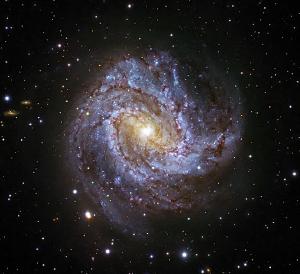Blog
Unlimited
1 March 2014
 NASA, ESA, S. Baum and C. O’Dea (RIT), R. Perley and W. Cotton (NRAO/AUI/NSF), and the Hubble Heritage Team (STScI/AURA)
NASA, ESA, S. Baum and C. O’Dea (RIT), R. Perley and W. Cotton (NRAO/AUI/NSF), and the Hubble Heritage Team (STScI/AURA)In 1916, Eddington demonstrated that there was a limit to how bright a stable star could be. The basic idea is that the atmosphere of a star is being gravitationally attracted by the mass of the star (giving it weight), and this weight is balanced by the pressure of the deeper layer of the star. For a star to be stable, the weight and pressure must be equal, so the star doesn’t collapse inward or push the atmosphere outward. We typically think of pressure as being due to gas and such, but light can also exert pressure on a material. We don’t notice light pressure in our daily lives because it is so small. Even in our Sun, the pressure on the atmosphere is relatively small, so the weight of our Sun’s atmosphere is mostly balanced by the pressure of the plasma in the layer underneath it. But if the Sun were brighter, the light it emits would push harder against the particles of the atmosphere. What Eddington showed is that there is a limit where the pressure of a star’s light on the atmosphere is large enough to balance the gravitational weight of the stellar atmosphere entirely, known as the Eddington luminosity limit. If the star were any brighter, the light of the star would push away the outer layers of the atmosphere, thus causing the star to lose mass.
 ESO/IDA/Danish 1.5 m/R. Gendler, S. Guisard and C. Thöne
ESO/IDA/Danish 1.5 m/R. Gendler, S. Guisard and C. ThöneThis same limit is often thought to hold for other objects, such as active galactic nuclei (AGNs) powered by black holes, but it also isn’t an absolute limit. When Eddington derived the limit he assumed a star that is spherical and non-rotating. Black holes are known to rotate, and their accretion disks are not spherical, so there have been proposed models that allow AGNs and other black holes to emit more power than the Eddington limit. There have been searches for such super-Eddington luminosity, but so far results have been inconclusive.
Now a new paper in Science has analyzed the energy output of a black hole in the galaxy M83, and found that it has emitted sustained levels of energy beyond the Eddington limit.1 Since the black hole was in a quiet phase when it was observed, the team could make an accurate determination of its mass by analyzing its accretion disk. They then looked at the effect of its jets, which were produced in an active period. They found that the energy of the jets clearly exceeded the Eddington limit.
By demonstrating that energy generated near black holes can exceed the Eddington limit, the authors have demonstrated that black holes can affect their environment in a more powerful way that originally thought.
Soria, Roberto, et al. “Super-Eddington mechanical power of an accreting black hole in M83.” Science 343.6177 (2014): 1330-1333. ↩︎